Key takeaways:
- Pro-life advocacy emphasizes supporting women and families through compassion, resources, and heartfelt conversations, beyond just opposing abortion.
- Coalitions amplify pro-life voices by uniting diverse stakeholders, enhancing outreach, and strengthening the collective message.
- Successful coalition formation requires clarity of shared goals, flexibility in approaches, and celebrating small victories to maintain motivation.
- Communication and recognizing individual member commitments are crucial in overcoming challenges and navigating differing philosophies within coalitions.
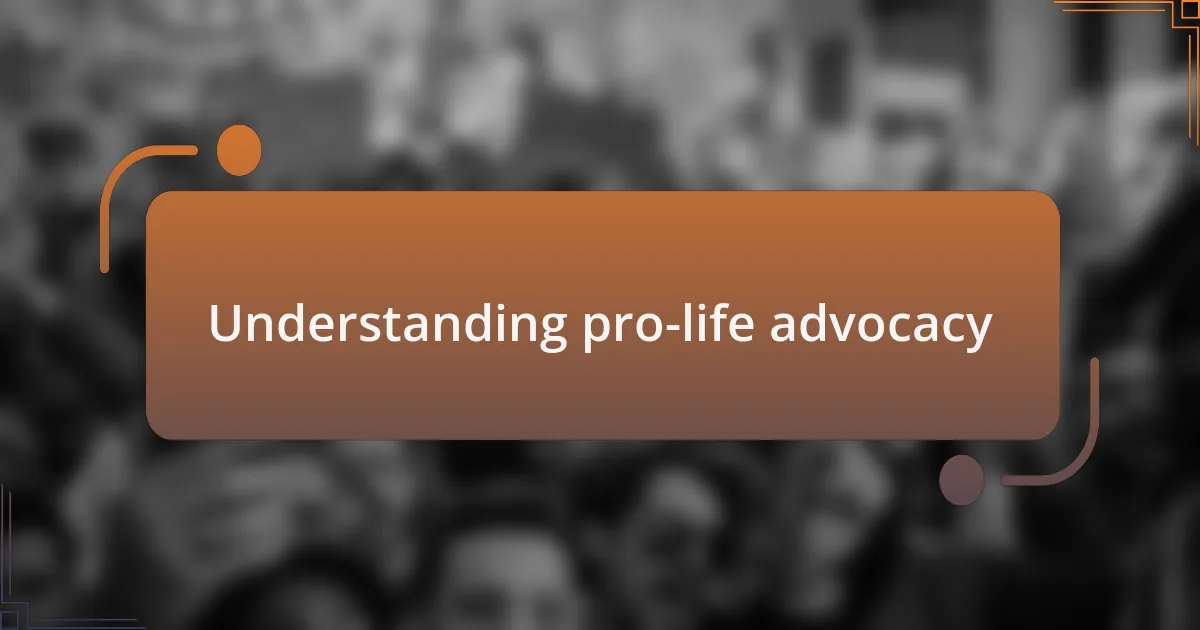
Understanding pro-life advocacy
Pro-life advocacy is rooted in the belief that every human life, from conception to natural death, possesses inherent value. I often think about the countless stories of mothers who faced unplanned pregnancies, yet chose to embrace and celebrate life despite their fears. Isn’t it inspiring to consider how these decisions can ripple outward, affecting families and communities in profound ways?
In my experience, pro-life advocacy isn’t just about opposing abortion; it’s about supporting women and families in real, tangible ways. I remember attending a local event where a speaker shared her journey of finding help and hope through unexpected challenges. Hearing her speak reminded me that advocacy must be compassionate—it’s essential to provide resources and support systems for those who feel alone in their choices.
When discussing this topic, have you ever considered how advocacy can bridge divides? I’ve seen friendships blossom across different beliefs when individuals engage in heartfelt conversations about life. Understanding pro-life advocacy requires us to remember that at its core, it’s about nurturing empathy and compassion for both the unborn and those who carry their futures.
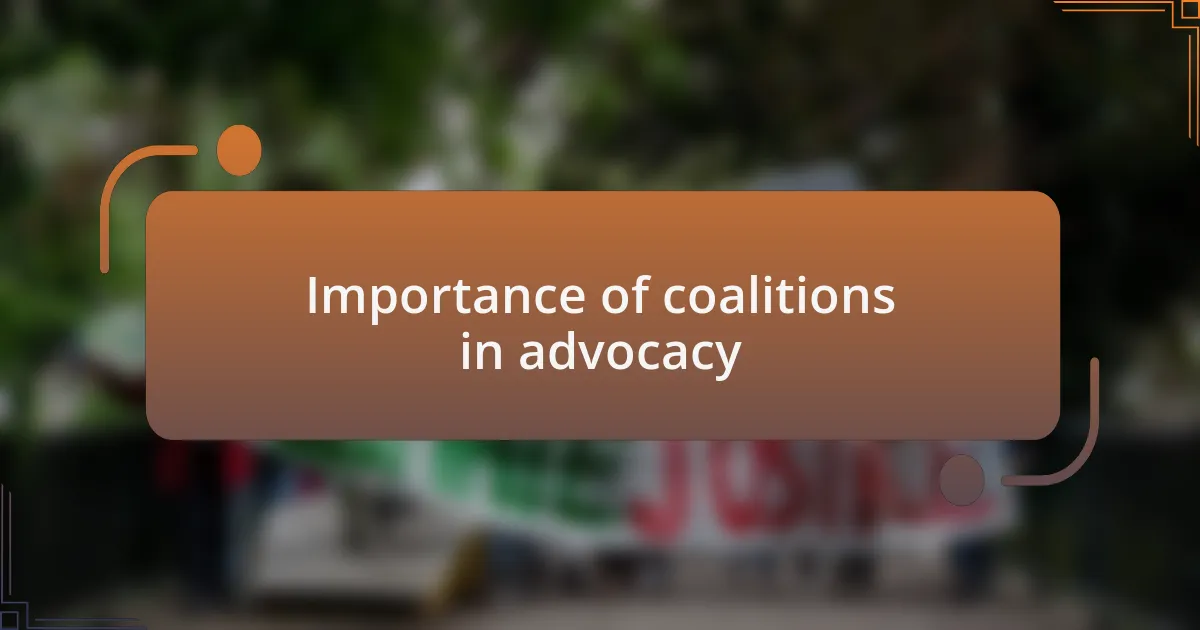
Importance of coalitions in advocacy
Coalitions play a pivotal role in amplifying the voices of pro-life advocates. I recall a time when our local group partnered with various organizations to create a comprehensive resource hub for expecting mothers. The collective effort not only broadened our outreach but also fostered a sense of community that empowered individuals to speak up for life. Who would have thought that collaboration could yield such a strong impact?
When I reflect on my journey in advocacy, the strength found in coalitions is undeniable. Joining forces with diverse groups often brings together shared resources, varied perspectives, and increased visibility for our cause. I remember attending a conference where different pro-life organizations came together, and it struck me how we all became more effective advocates when pooling our ideas and strategies.
Ultimately, sharing the load in advocacy ensures that no voice goes unheard. The synergy created through coalitions not only strengthens our message but fuels our passion to stand up for those who cannot stand for themselves. It often leaves me pondering: what more could we achieve if we continued to unite our efforts?

Identifying key stakeholders for change
Identifying key stakeholders for change starts with understanding who is most invested in the issue. I recall a moment during a community meeting where I realized the power of local businesses in advocating for pro-life initiatives. When we engaged them, they brought not only resources but also credibility to our cause, illustrating how diverse stakeholders can amplify our message.
In my experience, including voices from various sectors—such as healthcare professionals, educators, and even local government—can create a well-rounded coalition. There was a time when I reached out to a nearby hospital, and their support opened doors I hadn’t considered before. This taught me that the more inclusive our coalition is, the stronger our collective voice becomes.
Simply put, identifying key stakeholders requires us to think beyond traditional boundaries. Have you ever noticed how some of the most impactful advocates come from unexpected places? Engaging these groups often sparks new ideas and fresh perspectives, ultimately driving the change we yearn to see in the pro-life movement.
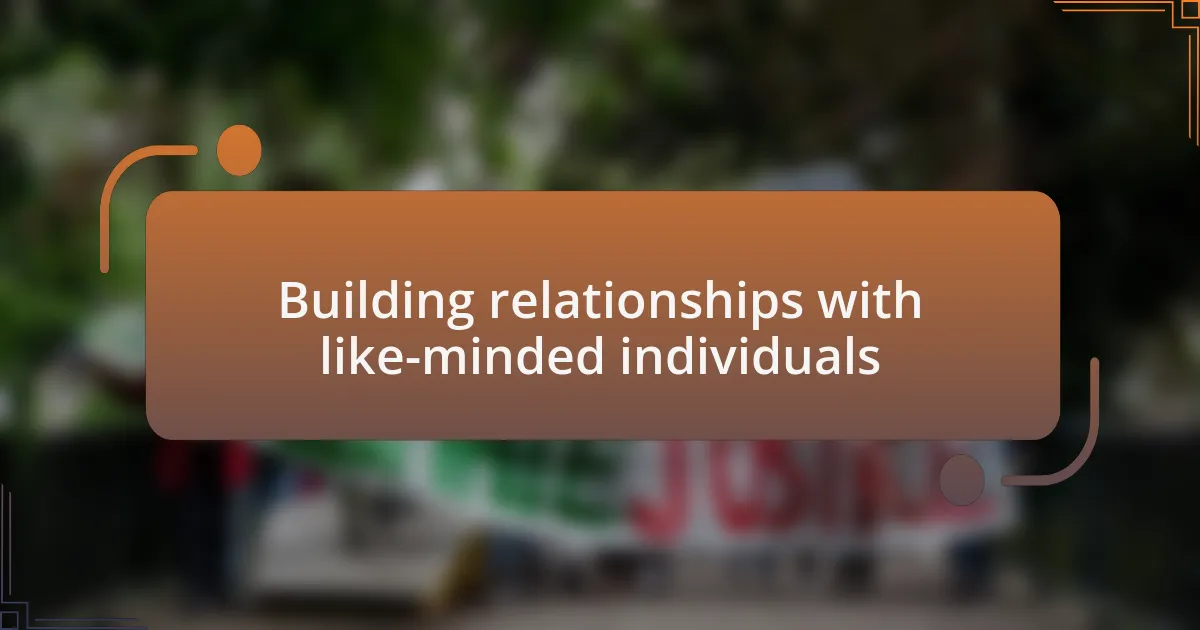
Building relationships with like-minded individuals
Cultivating relationships with like-minded individuals has been one of the most rewarding aspects of my advocacy journey. I remember attending a small gathering where we discussed our shared values around pro-life issues. It was in that intimate setting that I found not just allies, but friends who were equally passionate and committed, reminding me that collaboration can stem from genuine personal connections.
One conversation stands out vividly: I met a fellow advocate who had successfully organized outreach programs in her community. Her insights into establishing trust within the local demographic were eye-opening. I learned that by nurturing these relationships, we can create a support system that enhances our effectiveness, making our cause resonate on a deeper level with those we aim to reach.
Have you ever pondered how powerful it is to align with others who share your vision? Building these connections isn’t merely strategic; it’s about forging bonds that can withstand challenges. When we rally together, drawing on one another’s strengths and experiences, the momentum of our cause grows exponentially. Each interaction not only strengthens our coalition but also reinforces the values we hold dear in the fight for life.
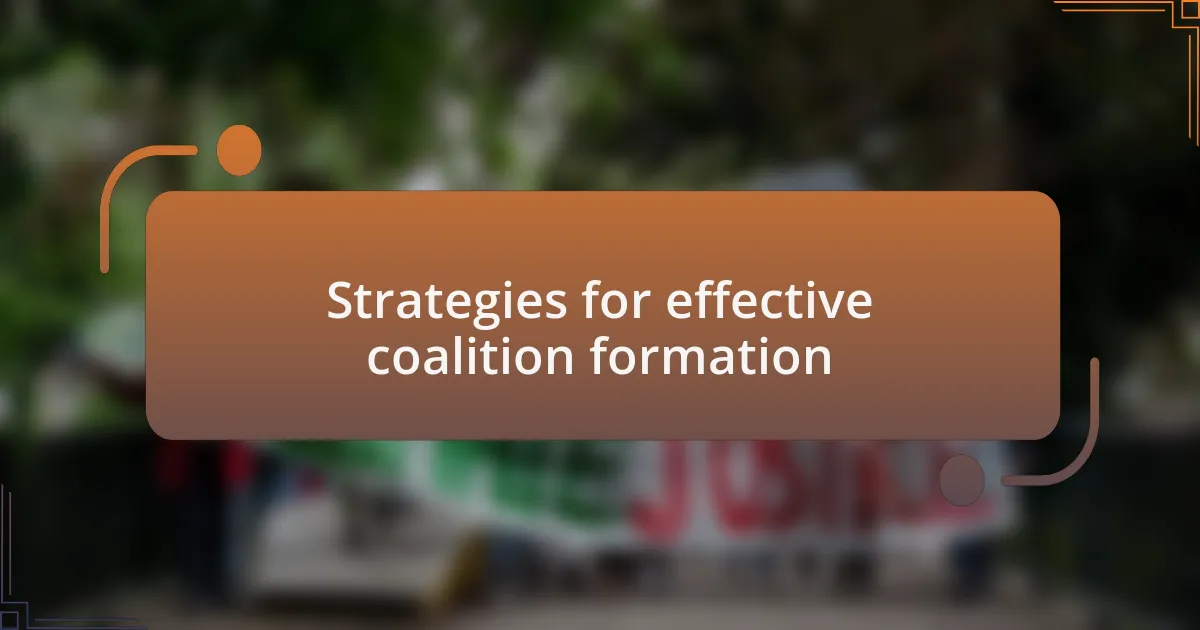
Strategies for effective coalition formation
When forming a coalition, it’s essential to identify shared goals and interests among potential partners. I recall a meeting where we took the time to map out our distinct objectives and how they aligned. This process not only clarified our mission but allowed everyone to feel valued and understood. Have you considered how a clear purpose can act as a magnet, drawing in diverse individuals while ensuring unity in action?
Flexibility is another vital strategy. I learned this the hard way during a proposed campaign that didn’t resonate with my partners. Instead of pushing forward, we revisited our initial discussions and adapted our approach, realigning it with our shared values. This willingness to pivot not only strengthened our coalition but also fostered a culture of respect and collaboration. Have you ever been surprised by how a simple adjustment can breathe new life into a project?
Lastly, always celebrate small victories together. I vividly remember when our coalition organized a successful local event that highlighted pro-life education. The joy was palpable, and sharing in that success fortified our bonds. Reflecting on these achievements gives us motivation to continue our crucial work. How often do you take the time to acknowledge milestones in your advocacy efforts? By doing so, we reinforce our commitment to the cause and to each other, ensuring a sustainable path forward.
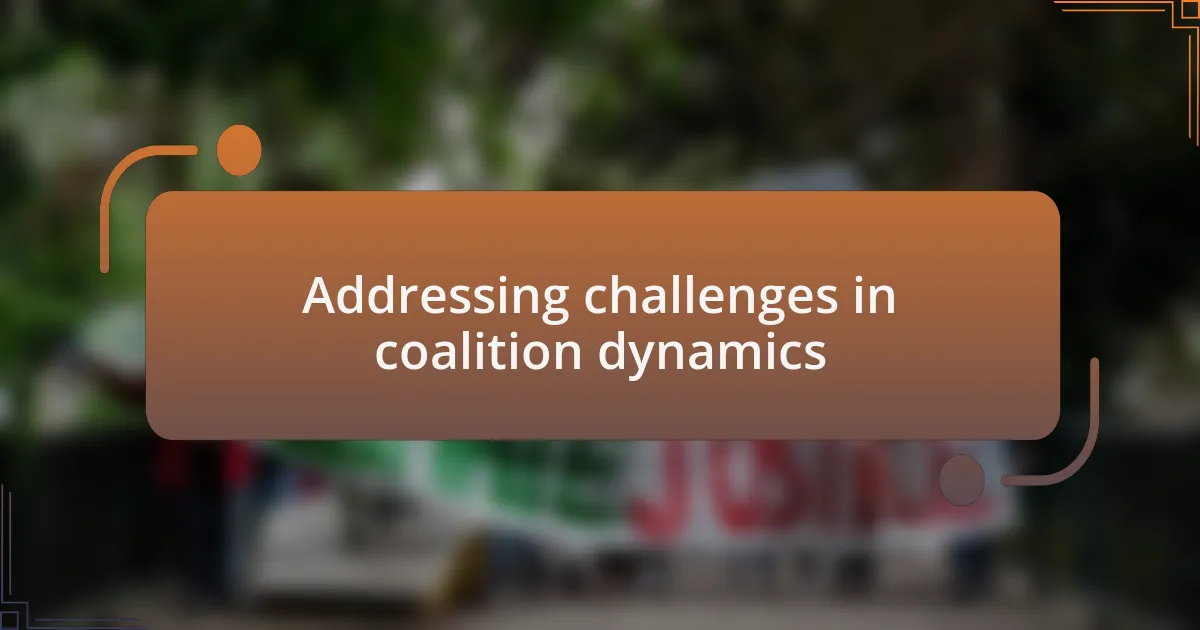
Addressing challenges in coalition dynamics
When addressing challenges in coalition dynamics, communication often emerges as a critical factor. I remember one particular instance where miscommunication nearly derailed our efforts. During a critical planning session, differing interpretations of our goals led to frustration. By taking a step back and openly discussing our viewpoints, we not only clarified our objectives but also developed a stronger mutual understanding. Isn’t it fascinating how dialogue can transform tension into teamwork?
Another significant challenge I encountered was balancing the varying levels of commitment among coalition members. Some were deeply invested, while others struggled to find the time. I recall a discussion where we acknowledged each member’s individual challenges, which allowed us to make adjustments in our roles based on availability and expertise. Have you noticed how recognizing personal circumstances can create a more inclusive environment?
Finally, navigating differing philosophies within the coalition can feel daunting. I once faced resistance from members who held contrasting views on strategy. Instead of ignoring these differences, I facilitated a session for open dialogue, which led to the unexpected discovery of common ground. This experience taught me that embracing diversity in perspectives can actually fuel creativity and strengthen our coalition’s resolve. Could it be that our differences, when acknowledged, enhance our collective vision rather than hinder it?
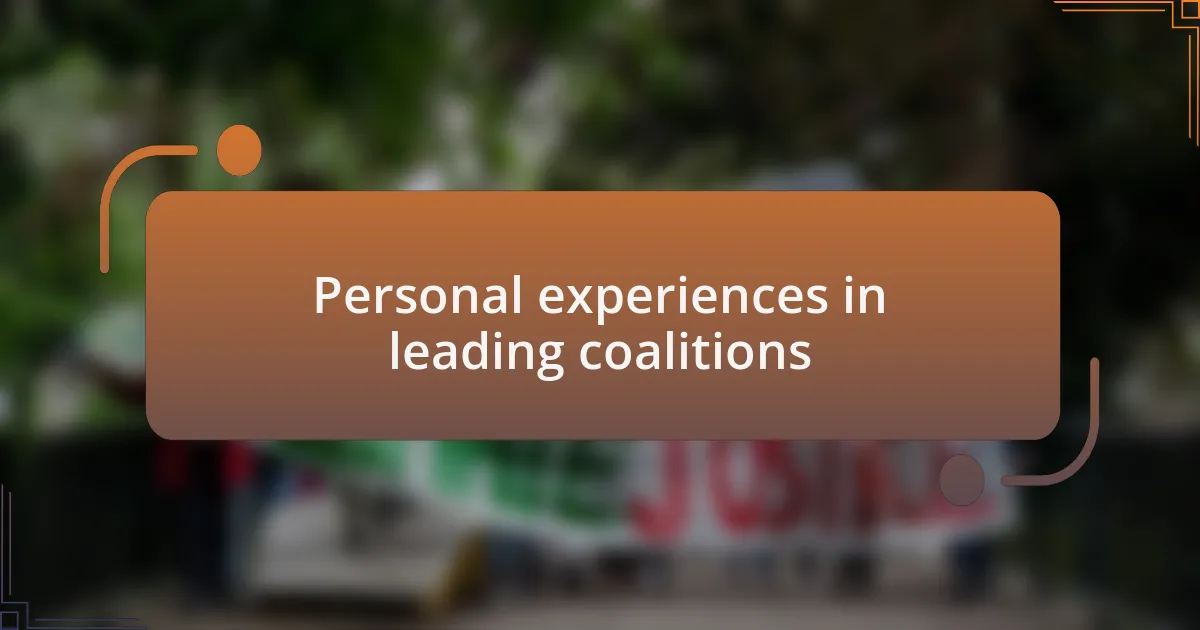
Personal experiences in leading coalitions
I recall my first experience leading a coalition, which was both exhilarating and nerve-racking. There was a moment when I felt overwhelmed by the responsibility of bringing various voices together. Initially, I doubted my ability to maintain harmony while pushing for change. Reflecting on that time, I realized that it was my willingness to learn from each member that truly forged our bond. Did you ever feel uncertain about stepping into a leadership role?
As I navigated through organizing events, I discovered the power of shared stories. During one gathering, we invited members to share their personal journeys, which opened up a floodgate of empathy and passion. I felt a wave of emotion as each story unfolded, reinforcing our shared mission. It was in those moments that I understood the profound impact of storytelling in bridging differences and fostering unity. How can the stories we tell reshape our connections?
One vivid challenge I faced was during a crucial legislative push. Some coalition members were hesitant to take a more public stance, fearing backlash. I shared my own fears regarding exposure but emphasized the importance of our collective voice. This candor helped alleviate their concerns, and it inspired them to step out of their comfort zones. It was a transformative moment for us, demonstrating how vulnerability can cultivate courage among peers. Have you ever witnessed a shift in dynamics simply by being open and honest?